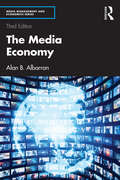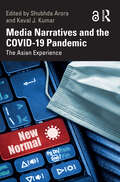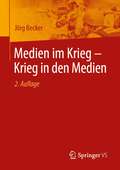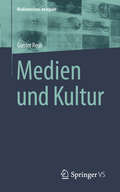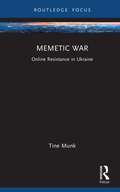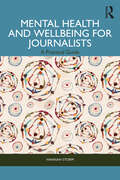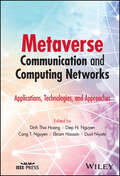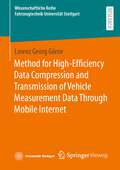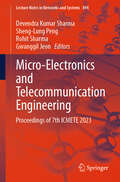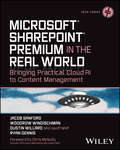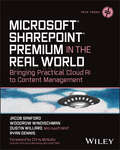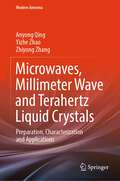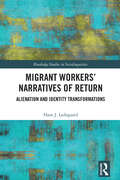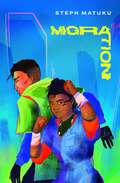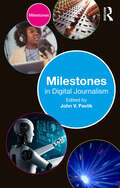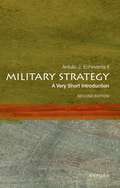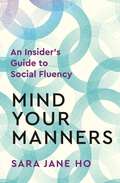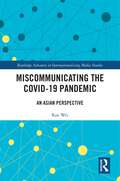- Table View
- List View
The Media Economy (Media Management and Economics Series)
by Alan B. AlbarranThis fully updated third edition analyzes the media industries and their activities from macro to micro levels, using concepts and theories to demonstrate the role the media plays in the economy as a whole. This textbook breaks new ground through its analysis of the rapidly changing and evolving media economy from two unique perspectives. First, the book explores how media industries function across global, national, household, and individual levels of society. Second, it assesses how key forces such as technology, globalization, regulation, and consumer aspects are constantly evolving and influencing media industries. This new edition incorporates thoroughly updated theory and research as well as expanded case studies that include examples from international markets such as Asia, Europe, and Latin America. It builds on the contributions of the previous edition by providing new references and current data to define and analyze today’s media markets and offers a more expansive assessment of streaming business models as well as the effects of Covid-19 on the media economy. Written in an accessible style and presenting a holistic global perspective of the role of media in the global economy, the textbook provides crucial insights for students and practitioners of media economics, media management and media industries.
Media Narratives and the COVID-19 Pandemic: The Asian Experience
This volume investigates mediated lives and media narratives during the Covid-19 pandemic, with Asia as a focus point. It shows how the pandemic has created an unprecedented situation in this globalized world marked by many disruptions in the social, economic, political, and cultural lives of individuals and communities— creating a ‘new normal’. It explores the different media vocabularies of fear, panic, social distancing, and contagion from across Asian nations. It focuses on the role media played as most nations faced lockdowns and unique challenges during the crisis. From healthcare workers to sex workers, from racism to nationalism, from the plight of migrant workers in news reporting to state propaganda, this book brings critical questions confronting media professionals into focus.The volume is of critical interest to scholars and researchers of media and communication studies, politics, especially political communication, social and public policy, and Asian studies.
Media Narratives and the COVID-19 Pandemic: The Asian Experience
by Shubhda Arora Keval J. KumarThis volume investigates mediated lives and media narratives during the Covid-19 pandemic, with Asia as a focus point. It shows how the pandemic has created an unprecedented situation in this globalized world marked by many disruptions in the social, economic, political, and cultural lives of individuals and communities— creating a ‘new normal’. It explores the different media vocabularies of fear, panic, social distancing, and contagion from across Asian nations. It focuses on the role media played as most nations faced lockdowns and unique challenges during the crisis. From healthcare workers to sex workers, from racism to nationalism, from the plight of migrant workers in news reporting to state propaganda, this book brings critical questions confronting media professionals into focus.The volume is of critical interest to scholars and researchers of media and communication studies, politics, especially political communication, social and public policy, and Asian studies.
Medien im Krieg – Krieg in den Medien
by Jörg BeckerDas Thema Medien und Krieg wird in diesem Buch aus einer vierfachen Perspektive heraus behandelt. Es geht zum einen um die Frage nach der Berichterstattung über Kriege, zum zweiten um die Rolle von Medien im Krieg, drittens geht es darum, welche strukturellen Bedingungen von Krieg und Gesellschaft die Inhalte der Medien wie prägen und viertens um eine friedensstiftende Sicht auf diese Zusammenhänge. Das Fazit: Definitorisch gibt es kaum noch einen Unterschied zwischen medialer Kommunikation und Krieg.Die zweite Auflage wurde um ein Kapitel über ukrainische Propaganda im Ukraine-Krieg ergänzt.
Medien und Kultur (Medienwissen kompakt)
by Gunter ReusMedien bestimmen unseren Alltag in jeder Lebenslage. Viele Menschen empfinden ihre Macht aber als gefährlich für die gesellschaftliche Kultur. Gunter Reus zeigt dagegen, wie sehr ein Gemeinwesen auf der kulturellen Leistung der Massenmedien aufbaut. Der Autor bedient sich dabei eines weiten Kulturbegriffs und zeichnet nach, wie sie Errungenschaften der Menschheit historisch ausgeformt haben. Ohne Medien gäbe es keine einheitliche Sprache und keinen Austausch von Information und Wissen, wie wir ihn kennen. Es gäbe keine Ausbalancierung sozialer Interessen, keine Kontrolle von Macht, keine Orientierung auf das Gemeinwohl, kein Kunstleben. Auch im Internetzeitalter bleiben Massenmedien, bei aller notwendigen Kritik an ihren Schattenseiten, unverzichtbar als Kulturträger. Sie sorgen für die Transparenz politischen Handelns ebenso wie für die (potentielle) Teilhabe aller am Kunstgeschehen. Damit prägen sie die Kultur der Demokratie wie auch die Kultur in der Demokratie entscheidend mit.
Memetic War: Online Resistance in Ukraine (Routledge Studies in Crime and Society)
by Tine MunkMemetic War analyses memetic warfare included in cyber war and aims to develop a framework for understanding the parameters included in utilising this concept in Ukraine as a part of civic resistance.In the Ukrainian war, an informal defence tactic has developed to uphold the information flow about the war and to debunk Russia’s communications. The war has enhanced the visibility of governmental and civic activation by using the advantages of social media architecture, networks, and communication forms. The book investigates Ukraine’s public and private abilities to develop cyber capabilities to counter propaganda and dis-and-misinformation online as a defence mechanism. This book uses military ROC doctrine to understand government authorities, the armed forces, and civic engagement in the Ukrainian resistance.Memetic War will have relevance for scholars, researchers, and academics in the cybersecurity field, practitioners, governmental actors, and military and strategic personnel.
Memetic War: Online Resistance in Ukraine (Routledge Studies in Crime and Society)
by Tine MunkMemetic War analyses memetic warfare included in cyber war and aims to develop a framework for understanding the parameters included in utilising this concept in Ukraine as a part of civic resistance.In the Ukrainian war, an informal defence tactic has developed to uphold the information flow about the war and to debunk Russia’s communications. The war has enhanced the visibility of governmental and civic activation by using the advantages of social media architecture, networks, and communication forms. The book investigates Ukraine’s public and private abilities to develop cyber capabilities to counter propaganda and dis-and-misinformation online as a defence mechanism. This book uses military ROC doctrine to understand government authorities, the armed forces, and civic engagement in the Ukrainian resistance.Memetic War will have relevance for scholars, researchers, and academics in the cybersecurity field, practitioners, governmental actors, and military and strategic personnel.
Mental Health and Wellbeing for Journalists: A Practical Guide
by Hannah StormThis book offers a first-of-its-kind, practical and person-centred guide to managing and contextualising journalists’ emotional wellbeing and mental health.Drawing on the author’s experience as a storyteller, journalist and media safety consultant, the book combines significant lived personal experience with reflections from an international network of journalists and mental health experts to collate industry good practice and guidance. It takes readers through a history of mental health discussions in the industry, moving from a focus on war correspondents and post-traumatic stress disorder to considerations of vicarious trauma, moral injury and the impact of online harm on journalists. It shows how pressures already faced by those in the sector have been exacerbated by the global pandemic, giving rise to the prospect of a mental health crisis in the media if these issues remain unaddressed. As a counter to this concern, Storm shares insights from experts on what leaders can do to create safer workplaces and processes, how they can channel the empathy that is core to healthy journalism to promote the health of its people, and how they should consider mental health as intersecting with other issues such as physical safety, diversity and inclusion. Insights from science shed light on resilience levels, how our brains and bodies respond to trauma, and strategies that can be adopted to help us recover from challenging experiences. While acknowledging that some news organisations are starting to take note, Storm shows how others need to do more, offering ways in which newsrooms can learn from the lessons of recent years to bring about long-lasting change.Mental Health and Wellbeing for Journalists is written for news media professionals, educators, and students, as well as anyone interested in promoting more sustainable journalism through supporting the industry’s most precious resource: its people.
Mental Health and Wellbeing for Journalists: A Practical Guide
by Hannah StormThis book offers a first-of-its-kind, practical and person-centred guide to managing and contextualising journalists’ emotional wellbeing and mental health.Drawing on the author’s experience as a storyteller, journalist and media safety consultant, the book combines significant lived personal experience with reflections from an international network of journalists and mental health experts to collate industry good practice and guidance. It takes readers through a history of mental health discussions in the industry, moving from a focus on war correspondents and post-traumatic stress disorder to considerations of vicarious trauma, moral injury and the impact of online harm on journalists. It shows how pressures already faced by those in the sector have been exacerbated by the global pandemic, giving rise to the prospect of a mental health crisis in the media if these issues remain unaddressed. As a counter to this concern, Storm shares insights from experts on what leaders can do to create safer workplaces and processes, how they can channel the empathy that is core to healthy journalism to promote the health of its people, and how they should consider mental health as intersecting with other issues such as physical safety, diversity and inclusion. Insights from science shed light on resilience levels, how our brains and bodies respond to trauma, and strategies that can be adopted to help us recover from challenging experiences. While acknowledging that some news organisations are starting to take note, Storm shows how others need to do more, offering ways in which newsrooms can learn from the lessons of recent years to bring about long-lasting change.Mental Health and Wellbeing for Journalists is written for news media professionals, educators, and students, as well as anyone interested in promoting more sustainable journalism through supporting the industry’s most precious resource: its people.
Metaverse Communication and Computing Networks: Applications, Technologies, and Approaches
by Dinh Thai Hoang Diep N. Nguyen Cong T. Nguyen Ekram Hossain Dusit NiyatoMetaverse Communication and Computing Networks Understand the future of the Internet with this wide-ranging analysis “Metaverse” is the term for applications that allow users to assume digital avatars to interact with other humans and software functions in a three-dimensional virtual space. These applications and the spaces they create constitute an exciting and challenging new frontier in digital communication. Surmounting the technological and conceptual barriers to creating the Metaverse will require researchers and engineers familiar with its underlying theories and a wide range of technologies and techniques. Metaverse Communication and Computing Networks provides a comprehensive treatment of Metaverse theory and the technologies that can be brought to bear on this new pursuit. It begins by describing the Metaverse’s underlying architecture and infrastructure, physical and digital, before addressing how existing technologies are being adapted to its use. It concludes with an overview of the challenges facing the Metaverse. The result is a thorough introduction to a subject that may define the future of the internet. Metaverse Communication and Computing Networks readers will also find: Detailed treatment of technologies, including artificial intelligence, Virtual Reality, Extended Reality, and more Analysis of issues including data security, ethics, privacy, and social impact A real-world prototype for Metaverse applications Metaverse Communication and Computing Networks is a must-own for researchers and engineers looking to understand this growing area of technology, and entrepreneurs interested in establishing Metaverse businesses.
Metaverse Communication and Computing Networks: Applications, Technologies, and Approaches
by Dinh Thai Hoang Diep N. Nguyen Cong T. Nguyen Ekram Hossain Dusit NiyatoMetaverse Communication and Computing Networks Understand the future of the Internet with this wide-ranging analysis “Metaverse” is the term for applications that allow users to assume digital avatars to interact with other humans and software functions in a three-dimensional virtual space. These applications and the spaces they create constitute an exciting and challenging new frontier in digital communication. Surmounting the technological and conceptual barriers to creating the Metaverse will require researchers and engineers familiar with its underlying theories and a wide range of technologies and techniques. Metaverse Communication and Computing Networks provides a comprehensive treatment of Metaverse theory and the technologies that can be brought to bear on this new pursuit. It begins by describing the Metaverse’s underlying architecture and infrastructure, physical and digital, before addressing how existing technologies are being adapted to its use. It concludes with an overview of the challenges facing the Metaverse. The result is a thorough introduction to a subject that may define the future of the internet. Metaverse Communication and Computing Networks readers will also find: Detailed treatment of technologies, including artificial intelligence, Virtual Reality, Extended Reality, and more Analysis of issues including data security, ethics, privacy, and social impact A real-world prototype for Metaverse applications Metaverse Communication and Computing Networks is a must-own for researchers and engineers looking to understand this growing area of technology, and entrepreneurs interested in establishing Metaverse businesses.
Method for High-Efficiency Data Compression and Transmission of Vehicle Measurement Data Through Mobile Internet (Wissenschaftliche Reihe Fahrzeugtechnik Universität Stuttgart)
by Lorenz Georg GörneLorenz Georg Görne presents a method (PrOComp) for optimal usage of the transmission path between the vehicle and the data backend. The compression ratio of vehicle measurement data could be improved from roughly a factor of ten in conventional methods, to up to 27. The method allows vehicle measurement data to be transmitted optimally in terms of data volume via the mobile internet and via traditional transmission routes. Through the PrOComp method, real-time data analysis over the mobile internet is feasible, as well as the collection of big data in the field. This enables key features like predictive maintenance, reactive event evaluation (for example crash events) or fast generation of AI training data. Through the usage of standardized interfaces and data formats, PrOComp can be adapted to the needs of many industry branches that feature field data collection.
Micro-Electronics and Telecommunication Engineering: Proceedings of 7th ICMETE 2023 (Lecture Notes in Networks and Systems #894)
by Devendra Kumar Sharma Sheng-Lung Peng Rohit Sharma Gwanggil JeonThe book presents high-quality papers from the Seventh International Conference on Microelectronics and Telecommunication Engineering (ICMETE 2023). It discusses the latest technological trends and advances in major research areas such as microelectronics, wireless communications, optical communication, signal processing, image processing, Big Data, cloud computing, artificial intelligence, and sensor network applications. This book includes the contributions of national/international scientists, researchers, and engineers from both academia and the industry. The contents of this book will be useful to researchers, professionals, and students alike.
Microsoft SharePoint Premium in the Real World: Bringing Practical Cloud AI to Content Management (Tech Today)
by Jacob J. Sanford Woodrow W. Windischman Dustin Willard Ryan DennisSkillfully deploy Microsoft SharePoint Premium to automate your organization’s document processing and management In Microsoft SharePoint Premium in the Real World: Bringing Practical Cloud AI to Content Management, a team of veteran Microsoft AI consultants delivers an insightful and easy-to-follow exploration of how to apply Syntex’ content AI and advanced machine learning capabilities to your firm’s document processing automation project. Using a simple, low-code/no-code approach, the authors explain how you can find, organize, and classify the documents in your SharePoint libraries. You’ll learn to use Microsoft SharePoint Premium to automate forms processing, document understanding, image processing, content assembly, and metadata search. Readers will also find: Strategies for using both custom and pre-built, “off-the-rack” models to build your solutions The information you need to understand the Azure Cognitive Services ecosystem more fully and how you can use it to build custom tools for your organization Examples of solutions that will allow you to avoid the manual processing of thousands of your own documents and files An essential and hands-on resource for information managers, Microsoft SharePoint Premium in the Real World is a powerful tool for developers and non-developers alike.
Microsoft SharePoint Premium in the Real World: Bringing Practical Cloud AI to Content Management (Tech Today)
by Jacob J. Sanford Woodrow W. Windischman Dustin Willard Ryan DennisSkillfully deploy Microsoft SharePoint Premium to automate your organization’s document processing and management In Microsoft SharePoint Premium in the Real World: Bringing Practical Cloud AI to Content Management, a team of veteran Microsoft AI consultants delivers an insightful and easy-to-follow exploration of how to apply Syntex’ content AI and advanced machine learning capabilities to your firm’s document processing automation project. Using a simple, low-code/no-code approach, the authors explain how you can find, organize, and classify the documents in your SharePoint libraries. You’ll learn to use Microsoft SharePoint Premium to automate forms processing, document understanding, image processing, content assembly, and metadata search. Readers will also find: Strategies for using both custom and pre-built, “off-the-rack” models to build your solutions The information you need to understand the Azure Cognitive Services ecosystem more fully and how you can use it to build custom tools for your organization Examples of solutions that will allow you to avoid the manual processing of thousands of your own documents and files An essential and hands-on resource for information managers, Microsoft SharePoint Premium in the Real World is a powerful tool for developers and non-developers alike.
Microwaves, Millimeter Wave and Terahertz Liquid Crystals: Preparation, Characterization and Applications (Modern Antenna)
by Anyong Qing Yizhe Zhao Zhiyong ZhangThis book is the first ever monograph on nematic liquid crystals for microwaves, millimeter waves and terahertz waves. It presents the first hand independent studies on nematic liquid crystals for microwaves, millimeter waves and terahertz waves. This book opens with an introduction to generic liquid crystals and a retrospective review about nematic liquid crystals in microwaves, millimeter waves and terahertz waves. Attention is then focused on the latest in-house progress on microwave, millimeter wave and terahertz nematic liquid crystals. Synthesis and characterization of novel nematic liquid crystals are first presented, followed by indigenous technologies to manufacture functional nematic liquid crystal devices for microwaves, millimeter waves and terahertz waves. A few self-developed representative advanced functional devices are shown to demonstrate the promising perspective of liquid crystals for not only microwaves, millimeter waves and terahertz waves but also many other non-display applications. The presented studies will attract scientists, engineers and students from various disciplines, such as materials, chemical, electrical, biological, and biomedical engineering. The book is intended for undergraduates, graduates, researchers, professionals and industrial practitioners who are interested in developing novel liquid crystals and further extending liquid crystals beyond display.
Migrant Workers’ Narratives of Return: Alienation and Identity Transformations (Routledge Studies in Sociolinguistics)
by Hans J. LadegaardDrawing on a corpus of 113 narratives told by migrant workers who have returned to their home country, Ladegaard details Indonesian and Filipina (domestic) migrant workers’ experiences of homecoming after years of work abroad, separated from their loved ones. The narratives deal with two major themes: 1) Migrant workers’ experiences in the diaspora, which for many, particularly Indonesian workers, were associated with abuse and exploitation leading to trauma; and 2) migrant workers’ experiences of coming home, which include both the happy reunion with the family but also concerns about not ‘fitting in’ and the need to reinvent themselves because they are not who they were when they left. This is particularly true for workers whose migratory journeys have failed and who have come back to their hometowns without any financial award. Chapters also explore the major difference between Filipina and Indonesian migrant workers’ overseas experiences. The Filipina returnees share mostly positive stories while the Indonesian returnees uncover mostly negative stories, further illuminating what may explain these diverse migratory experiences. Finally, the book discusses how research on disenfranchised groups like (domestic) migrant workers can be used for social and political action. An excellent text that will appeal to academics, teachers and postgraduate students in the humanities and social sciences, particularly in sociolinguistics, applied linguistics, intercultural communication, anthropology, and migration studies.
Migrant Workers’ Narratives of Return: Alienation and Identity Transformations (Routledge Studies in Sociolinguistics)
by Hans J. LadegaardDrawing on a corpus of 113 narratives told by migrant workers who have returned to their home country, Ladegaard details Indonesian and Filipina (domestic) migrant workers’ experiences of homecoming after years of work abroad, separated from their loved ones. The narratives deal with two major themes: 1) Migrant workers’ experiences in the diaspora, which for many, particularly Indonesian workers, were associated with abuse and exploitation leading to trauma; and 2) migrant workers’ experiences of coming home, which include both the happy reunion with the family but also concerns about not ‘fitting in’ and the need to reinvent themselves because they are not who they were when they left. This is particularly true for workers whose migratory journeys have failed and who have come back to their hometowns without any financial award. Chapters also explore the major difference between Filipina and Indonesian migrant workers’ overseas experiences. The Filipina returnees share mostly positive stories while the Indonesian returnees uncover mostly negative stories, further illuminating what may explain these diverse migratory experiences. Finally, the book discusses how research on disenfranchised groups like (domestic) migrant workers can be used for social and political action. An excellent text that will appeal to academics, teachers and postgraduate students in the humanities and social sciences, particularly in sociolinguistics, applied linguistics, intercultural communication, anthropology, and migration studies.
Migration
by Steph MatukuFarah of Untwa joins a school for training fighters, strategic thinkers and military personnel. It means she escapes her domineering mother and the tedious duties that come with being from a Ngāti in the upper echelons of society. But at the school, Farah, an intuitive, is teamed up with fighter Lase, a boy from a lower Ngāti. Farah's condescension and disturbing hallucinations and Lase's resentment test their partnership. But just when they finally seem to be working well together, the school is attacked by other-worldly forces. Farah and Lase must use their skills to fight the alien invaders and save their people from obliteration.
Milestones in Digital Journalism (Milestones)
by John V. PavlikMilestones in Digital Journalism sets out ten defining moments that changed the way we understand, produce, finance and engage with the news today.Designed for weekly use on digital journalism courses, these ten milestones provide a conceptual roadmap to understanding the subject while drawing on case study examples which help students home in on key markers in its history. Each milestone is selected for its impact on the nature of journalism practice, the content of journalism, the structure of the journalism industry and/or public engagement in the news. Milestones are defined as the key markers in the development of digital journalism worldwide since the 1970s. The featured markers are diverse and global, ranging from the first virtual reality (VR) screening of Nonny de la Peña’s Hunger in Los Angeles at Sundance Film Festival, to citizen reporting of the police killing of George Floyd in 2020. Written by experts in each of the areas chosen, this book offers an inclusive and de-centred overview of the field and an ideal springboard for further study.Milestones are a range of accessible textbooks, breaking down the need-to-know moments in the social, cultural, political and artistic development of foundational subject areas.This book is key reading for students learning about the history of digital journalism worldwide.
Milestones in Digital Journalism (Milestones)
Milestones in Digital Journalism sets out ten defining moments that changed the way we understand, produce, finance and engage with the news today.Designed for weekly use on digital journalism courses, these ten milestones provide a conceptual roadmap to understanding the subject while drawing on case study examples which help students home in on key markers in its history. Each milestone is selected for its impact on the nature of journalism practice, the content of journalism, the structure of the journalism industry and/or public engagement in the news. Milestones are defined as the key markers in the development of digital journalism worldwide since the 1970s. The featured markers are diverse and global, ranging from the first virtual reality (VR) screening of Nonny de la Peña’s Hunger in Los Angeles at Sundance Film Festival, to citizen reporting of the police killing of George Floyd in 2020. Written by experts in each of the areas chosen, this book offers an inclusive and de-centred overview of the field and an ideal springboard for further study.Milestones are a range of accessible textbooks, breaking down the need-to-know moments in the social, cultural, political and artistic development of foundational subject areas.This book is key reading for students learning about the history of digital journalism worldwide.
Military Strategy: Second Edition (Very Short Introductions)
by Antulio J. Echevarria IIDistilling the ideas of the greatest military theoreticians of history, including Sun Tzu, Niccol? Machiavelli, and Carl von Clausewitz, this clear and engaging Very Short Introduction presents a fascinating account of the "art of the general." Antulio J. Echevarria II highlights the dynamic relationship between the main elements of strategy: purpose, method, and means. Drawing on historical examples, he discusses the major types of military strategy and how emerging technologies are affecting them. This second edition has been updated throughout, and now includes an extended chapter on cyberwarfare which shows how the use of social media platforms to influence opinions on political views and manipulate populations to act in certain ways has evolved from an art to a science.
Mind Your Manners: An Insider's Guide to Social Fluency
by Sara Jane HoFounder of a global etiquette school and star of her own Netflix series, Mind Your Manners, Sara Jane Ho teaches readers how to thrive socially in a variety of situations, in person and online.Structured around five main 'microcultures' – Friendship and Social Life, Family Ties, Career-ing, Dating & Relationships, Food & Travel – Mind Your Manners reveals the subtle differences in expectation within each, and how to read the situation you find yourself in with ease and confidence so that you may respond appropriately.In Sara Jane's brilliant hands, etiquette becomes fresh, dynamic, and situation-specific, rather than strict and unforgiving. Sara Jane’s etiquette is contextual etiquette. Transcending old notions of manners entirely, it is nothing less than the art and science of interacting with others.
Miscommunicating the COVID-19 Pandemic: An Asian Perspective (Routledge Advances in Internationalizing Media Studies)
by Ran Wei Ven-Hwei Lo Yi-Hui Christine Huang Dong Dong Hai Liang Guanxiong Huang Sibo WangThis book tackles the infodemic—the rapid, widespread diffusion of false, misleading, or inaccurate information about the disease and its ramifications—triggered by the COVID-19 pandemic. With a focus on four Asian societies, the book compares and analyzes the spread of COVID-19 misinformation and its broad impacts on the public in Beijing, Hong Kong, Taipei, and Singapore. Providing both a comprehensive overview of the phenomenon of misinformation and cross-societal analyses of patterns, the book features in-depth analyses of the prevalence of COVID-19 misinformation and engagement and explores its consequences in an Asian context. The book sheds lights on these key questions: What types of infodemic messages circulate widely on popular social media platforms? What factors account for exposure to and engagement with debunked yet popular COVID-19 misinformation? How does exposure to widely circulated COVID-19 misinformation affect people’s beliefs, attitudes, and adoption of preventive measures to cope with the pandemic? How do macro social differences condition the diffusion and impacts of COVID-19 misinformation? What intervention strategies can counter the misinformation? Presenting scientific insights and empirical findings on the pressing issues about infodemic, this book will be of great interest to students and researchers of communication studies, political science, public health, crisis communication, and Asian Studies, as well as policymakers and practitioners who wish to acquire cutting-edge, evidence-based knowledge about combating misinformation during a global pandemic.
Miscommunicating the COVID-19 Pandemic: An Asian Perspective (Routledge Advances in Internationalizing Media Studies)
by Ran Wei Ven-Hwei Lo Yi-Hui Christine Huang Dong Dong Hai Liang Guanxiong Huang Sibo WangThis book tackles the infodemic—the rapid, widespread diffusion of false, misleading, or inaccurate information about the disease and its ramifications—triggered by the COVID-19 pandemic. With a focus on four Asian societies, the book compares and analyzes the spread of COVID-19 misinformation and its broad impacts on the public in Beijing, Hong Kong, Taipei, and Singapore. Providing both a comprehensive overview of the phenomenon of misinformation and cross-societal analyses of patterns, the book features in-depth analyses of the prevalence of COVID-19 misinformation and engagement and explores its consequences in an Asian context. The book sheds lights on these key questions: What types of infodemic messages circulate widely on popular social media platforms? What factors account for exposure to and engagement with debunked yet popular COVID-19 misinformation? How does exposure to widely circulated COVID-19 misinformation affect people’s beliefs, attitudes, and adoption of preventive measures to cope with the pandemic? How do macro social differences condition the diffusion and impacts of COVID-19 misinformation? What intervention strategies can counter the misinformation? Presenting scientific insights and empirical findings on the pressing issues about infodemic, this book will be of great interest to students and researchers of communication studies, political science, public health, crisis communication, and Asian Studies, as well as policymakers and practitioners who wish to acquire cutting-edge, evidence-based knowledge about combating misinformation during a global pandemic.
